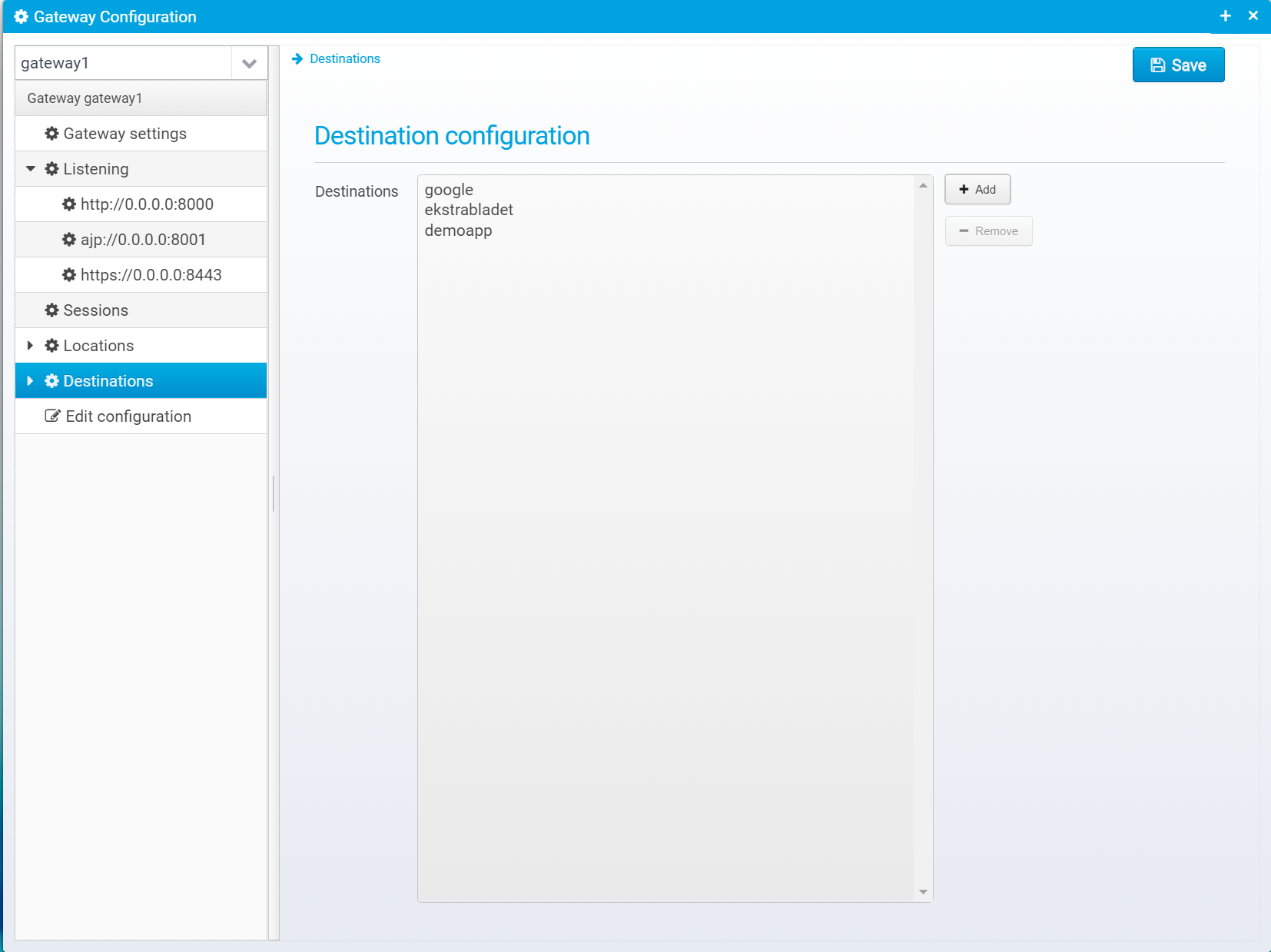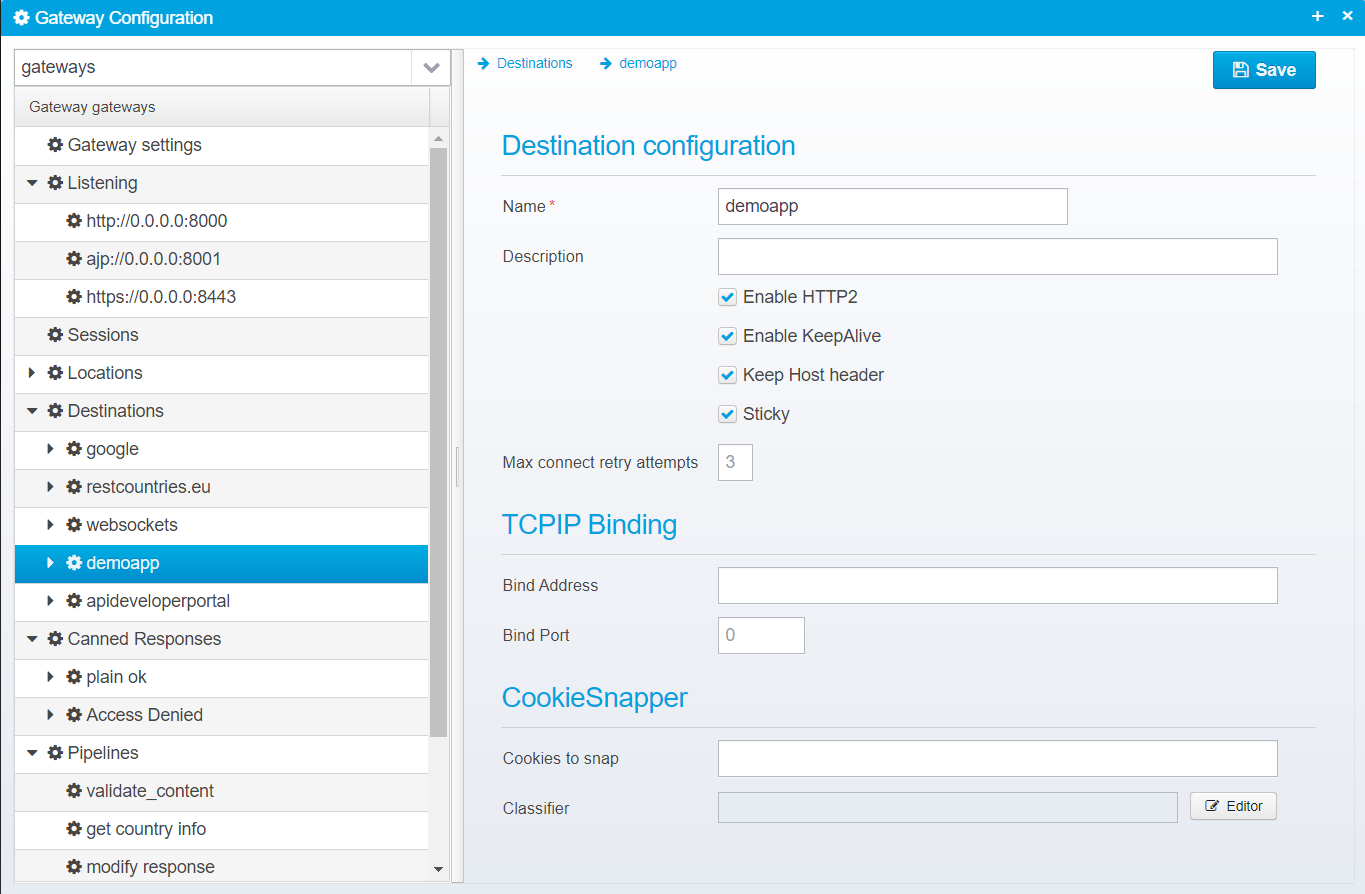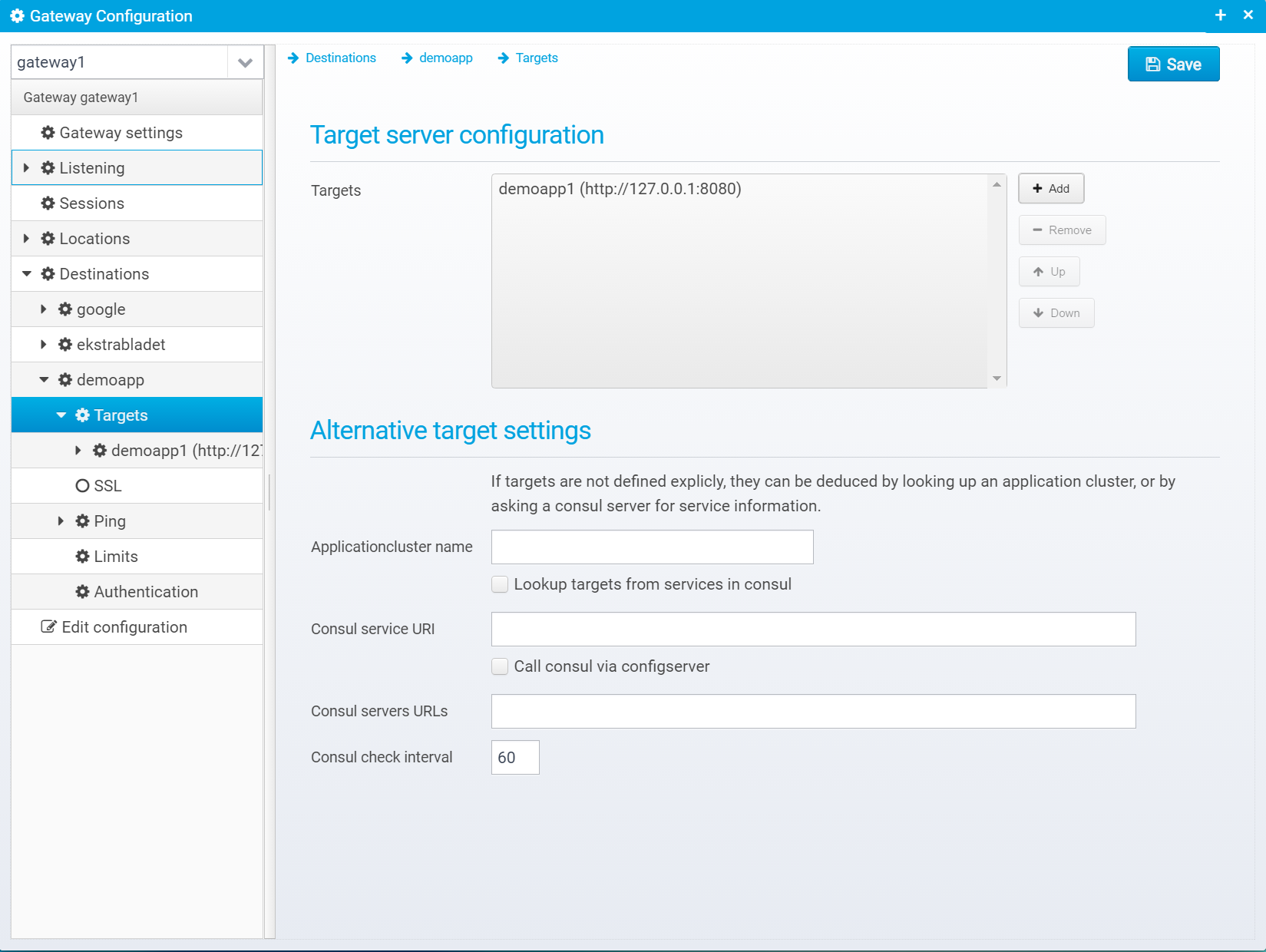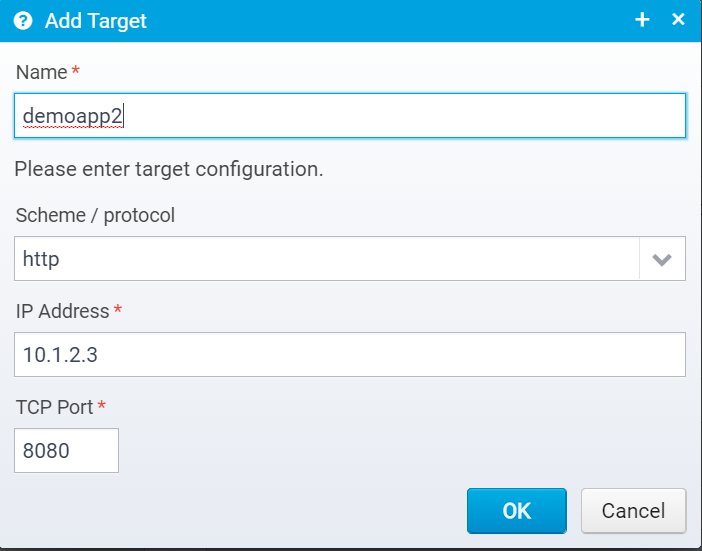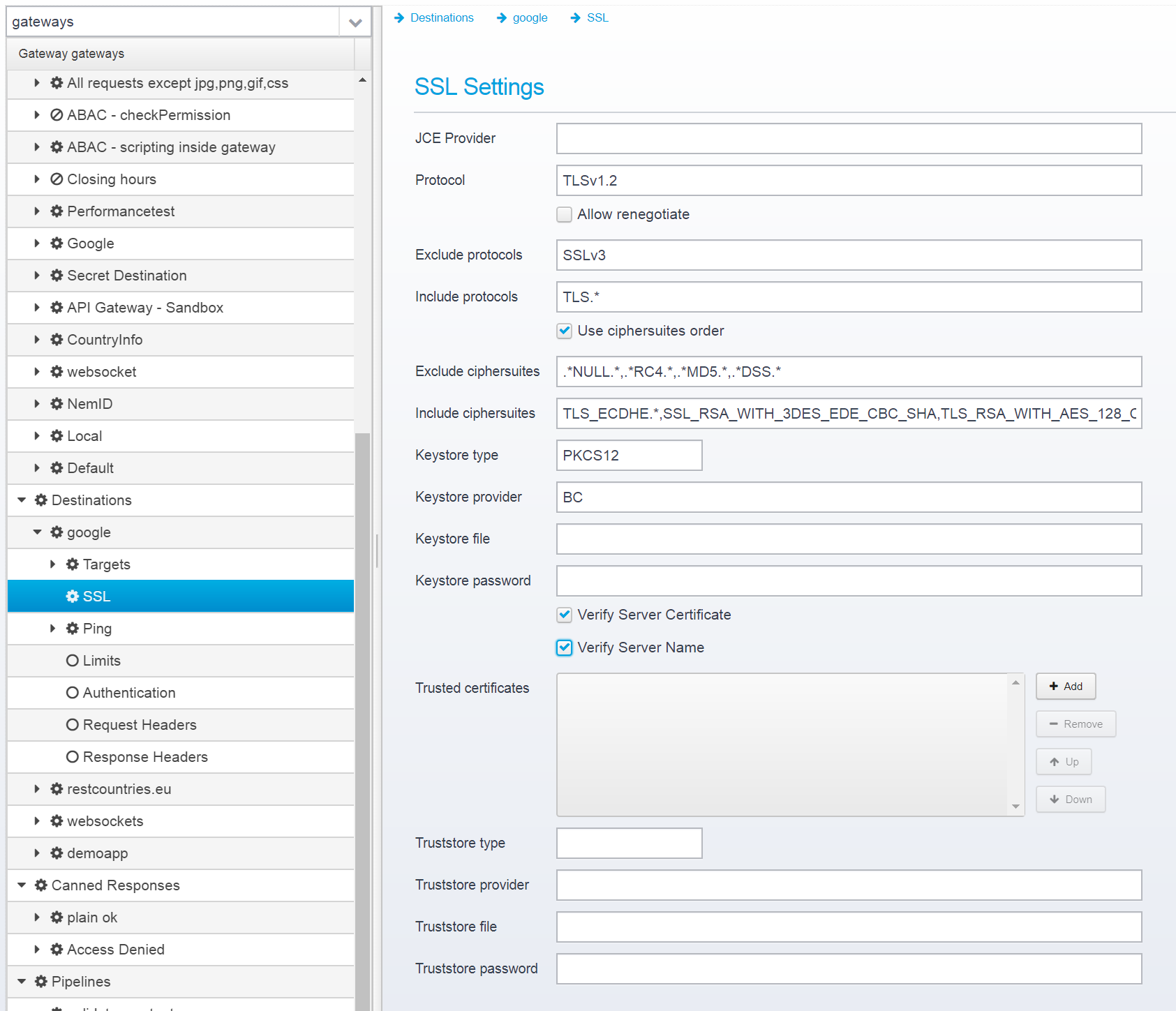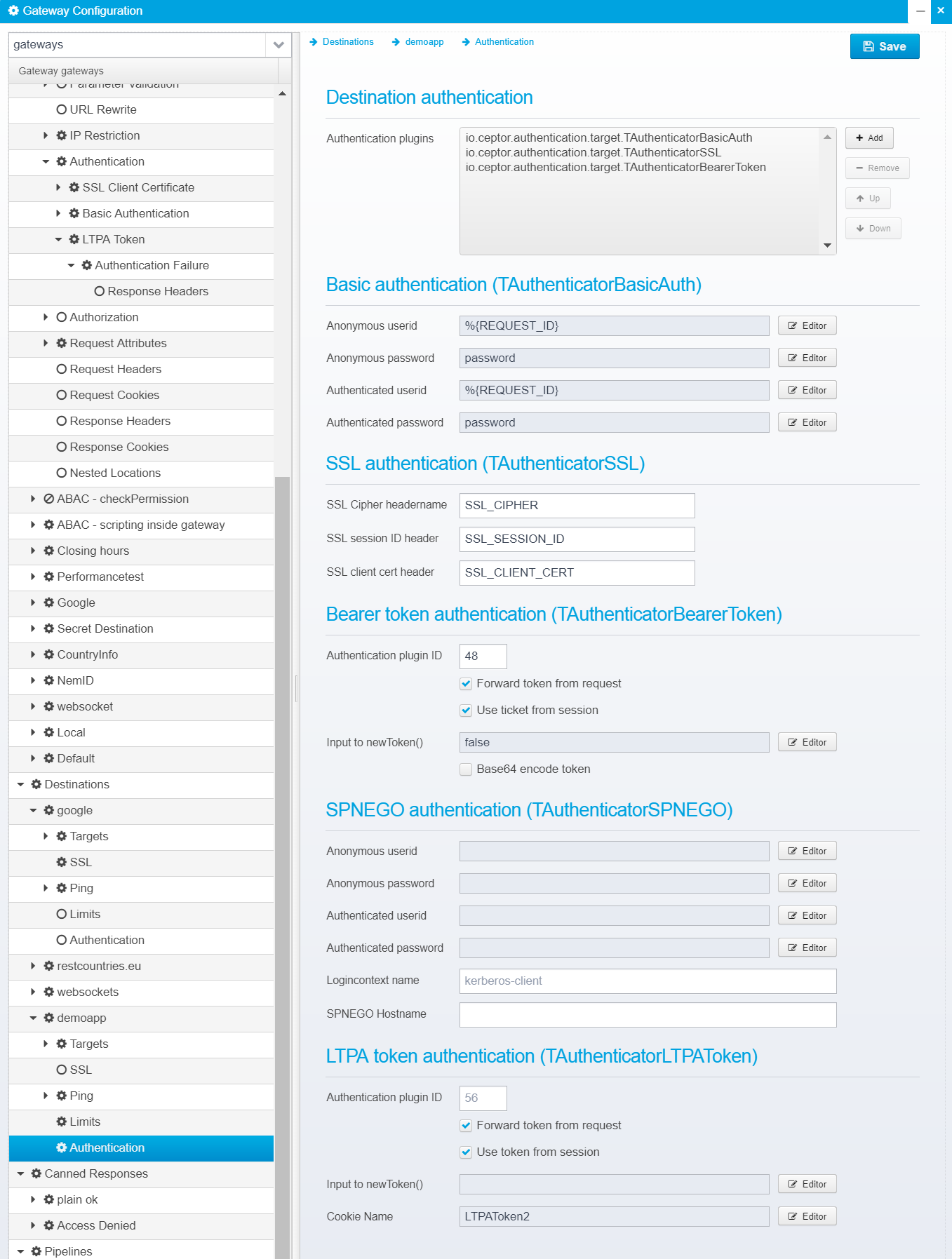Config - Destinations
JSON Configuration for Destinations
"destinations" is an array of JSON objects where each object contains the configuration for a single destination.
{
"destinations": [
{
"name": "demoapp",
"description": "Demonstration application",
"cookiesnapper": {
"pattern": "JSESSIONID",
"classifier": "default"
},
"ping": {
"expect": "200",
"timeout.seconds": 5,
"method": "HEAD",
"uri": "/",
"meod": "GET",
"interval.seconds": 30,
"response.verify.script": "if (input.contains('For further information about PortalProtect')) true; else false;"
},
"loadbalance": "roundrobin",
"target.consul.askviaconfigserver": false,
"target.consul.interval": 60,
"targets": [{
"scheme": "http",
"port": 8080,
"unavailable": false,
"name": "demoapp1",
"host": "127.0.0.1",
"disabled": false,
"limits": {
"queue.length": 100,
"max.idle.connections.hard": 20,
"idle.ttl": 10,
"max.idle.connections.soft": 5,
"max.concurrent.requests": 20
}
}],
"limits": {
"queue.length": 200,
"max.idle.connections.hard": 20,
"idle.ttl": -1,
"max.idle.connections.soft": 5,
"max.concurrent.requests": 10
},
"authentication": {
"plugins": [
"io.ceptor.authentication.target.TAuthenticatorBasicAuth",
"io.ceptor.authentication.target.TAuthenticatorSSL",
"io.ceptor.authentication.target.TAuthenticatorBearerToken"
],
"basicauth": {
"password": "password",
"anonymous.password": "password",
"anonymous.userid": "%{REQUEST_ID}",
"userid": "%{REQUEST_ID}"
},
"bearer": {
"authenticationplugin": 48,
"forward.from.request": true,
"call.newtoken": false,
"base64encode": false,
"newtoken.input": null,
"use.ticket.from.session": true
},
"ssl": {
"header.cipher": "SSL_CIPHER",
"header.sessionid": "SSL_SESSION_ID",
"header.clientcert": "SSL_CLIENT_CERT"
},
"request.headers": [
{
"name": "X-Forwarded-For",
"value": "%{REMOTE_ADDR}"
}
],
"response.headers": []
}
},
{
"sslcontext": {
"ssl.protocol": "TLS",
"keystore.provider": "BC",
"keystore.type": "PKCS12",
"verify.server.certificate": true,
"verify.server.name": true,
"excludeprotocols": "SSLv3",
"allowrenegotiate": false,
"trusted.server.certificates": [],
"excludeciphersuites": ".*NULL.*,.*RC4.*,.*MD5.*,.*DSS.*",
"includeprotocols": "TLS.*",
"includeciphersuites": "TLS_ECDHE.*,SSL_RSA_WITH_3DES_EDE_CBC_SHA,TLS_RSA_WITH_AES_128_CBC_SHA",
"useciphersuites.order": true
},
"http2.enable": true,
"keepalive.enable": true,
"max.connect.retries": 3,
"ping": {
"expect": "200|302",
"method": "HEAD",
"uri": "/",
"interval.seconds": 60
},
"name": "google",
"sticky": false,
"keep.hostheader": true,
"description": "Proxying requests to google",
"targets": [{
"scheme": "https",
"port": 443,
"unavailable": false,
"name": "google1",
"host": "www.google.com",
"disabled": false
}]
},
]
}
Configuration Using Ceptor Console
Here is the list of destinations, where you can add new destinations, or remove existing ones.
When you click Add, you get this prompt:
where you need to enter a name and optionally a description for your own use.
When you have entered this, you are brought to the Destination Configuration
Configuration is stored in the JSON object for the destination directly
The configuration on this screen is split into 2 different sections.
Destination Configuration
Name
Name of destination - used for logging/debugging and stickiness (hash of name is in the sticky cookie)
Default: none, a name is required
JSON key: name
Description
Description of destination - an optional description for your own use.
Default: none
JSON key: description
Enable HTTP2
Enable HTTP/2 protocol support - if not checked, HTTP 1.1 will be used instead when making connections towards the server.
Whenever possible, you should enable this, since HTTP/2 performs significantly better than older versions of the HTTP protocol.
Some servers that do not support HTTP2 fail by closing the SSL connection with a decrypt error if this flag is set, so if you use https connections to a target server, and it keeps failing by closing the connection during SSL handshake, this could be the cause. You can use Wireshark or a similar protocol analyzer to determine
Default: false
JSON key:http2.enable
Enable KeepAlive
If set, enables HTTP keepalive support - if not set, new connections will be created for each request which performs a lot worse than when enabled.
Default: true
JSON key: keepalive.enable
Keep Host header
If set, existing HOST header is kept and forwarded unmodified to the target server - if not, it is discarded and a new HOST header matching the target servers host and port is sent instead.
This setting is off by default, to comply with RFC7230 specifying a proxy behavior in the HTTP protocol. You might want to enable it for providing backend servers a chance to react to virtual host settings. Note that newer backend webservers can do the same by looking either at X-Forwarded-Host or Forwarded (RFC7239) HTTP headers and reacting to them, assuming the gateway has been configured to send these headers too.
Default: false
JSON key: keep.hostheader
Sticky
If set, stickiness is enabled, meaning a sticky cookie is set, so user hits the same server again next time.
Default: true
JSON key: sticky
Max connect retry attemps
The number of retries in case connection fails to one of the target servers.
Default: 3
JSON key: max.connect.retries
TCP Binding
Bind Address
If specified, this is the address to bind to when making the connection to the target server - leave blank to auto assign. This is useful when you want to select a particular network interface.
Default: blank
JSON key: bindaddress
Minimum Version: 5.61
Bind Port
TCP port to bind to when connecting to target server. Set to 0 to autoassign port. Only used when also specifying the bind address
Default: 0
JSON key: bindport
Minimum Version: 5.61
CookieSnapper
Configuration is stored in the JSON object cookiesnapper.
Cookies to snap
Pattern defining which cookies to remove from the response and place into the session. Any cookies matching this pattern will be moved from the response to the session, and added on future requests.
Default value: blank
JSON key: pattern
Classifier
Classifier to use - here you can use %{} variables, such as %{HTTP_HOST} or %{script:xxxx} to specify the classifier or scope to restrict these cookies too.
The classifier can ensure that the cookies are not forwarded on all requests, but only where the next request has the same classifier - so if it is e.g. set to %{HTTP_HOST} then the cookie will only be added to future requests, if these requests has the exact same hostname as this one.
If the classifier is left as "default" then if the next request has a different hostname, e.g. app2.mydomain.com then the cookie will be added to the request again, which is usually what you want.
Default value: "default"
JSON key: classifier
Targets
A destination server has one or more target servers attached to it - target servers can be configured individually, or they can come from an application cluster, or even a consul service repository.
Target Server Configuration
Target server config is stored in the JSON object targets
To add a new target, click "Add", this will give you this screen:
where you must give the target server a name that is unique for the destination, and select a scheme (http/https) and specify its IP address and TCP port number.
See Destination Target Servers for details.
Alternative target settings
As an alternative to defining each target server one at a time, you can configure the gateway to use either an application cluster or do a consul service lookup.
An application cluster is a dynamic cluster created by importing a directory of configuration files into one, so the act of act of adding or removing the server is simply adding or removing a file within this directory. See Ceptor Configuration Server for details.
A consul service repository is also supported - se https://www.consul.io for information.
Applicationcluster name
Name of application cluster to automatically choose targets from - all servers in the applicationcluster will be used"
Must be specified in the form of a macro - eg. ${applicationcluster:target:xxxxx} - where xxxxx is the name of the application cluster. See the Macros section in Ceptor Configuration Server for more info.
Default: none
JSON key: target.applicationcluster
Lookup targets from services in consul
If set, lookup additional targets in consul using the configured consul service URI and consul server URLs
Default: false
JSON key: target.consul.enabled
Consul service URI
Service URL to query - e.g. /v1/catalog/service/customerservice
Default: none (but required when consul lookups are enabled)
JSON key: target.consul.serviceuri
Call consul via configserver
If set, the "Consul servers URLs" is not used, but instead the config server is asked to call consul on behalf of the gateway.
Default: false
JSON key: target.consul.askviaconfigserver
Consul servers URLs
List of URLs (separated by semicolon) to consul server(s), Do not include path - e.g. https://server1:4443;https://server2:4443
Default: none (but required when consul lookups are enabled, unless "Call consul via configserver" is set)
JSON key: target.consul.url
Consul check interval
Interval in seconds between checking consul for updates
Default: 60
JSON key: target.consul.interval
SSL Settings
SSL settings for all target servers in this destination, unless overridden for a particular target server.
They are saved in the JSON key sslcontext within the specific destination JSON Object.
SSL Settings
JCE Provider
Name of SSL JCE Provider to use, or leave blank for default JDK
Default: blank, meaning JDK default.
JSON key: ssl.provider
Protocol
Name of SSL Protocol (e.g. TLS), or leave blank for default. Note that some SSL protocols are insecure - but old server implementations might require you to use an older protocol - typical protocols are TLS, TLSv1.1, TLSv1.2
Default: blank, meaning JDK default.
JSON key: ssl.protocol
Allow renegotiate
Allow unsecure renegotiation, turn off for best security.
Default: false
JSON key: allowrenegotiate
Exclude protocols
Comma/semicolon separated list of SSL protocols to exclude from the JCE default protocols list - patterns are regex expressions.
Default: SSL,SSLv2,SSLv2Hello,SSLv3
JSON key: excludeprotocols
Include protocols
Comma/semicolon separated list of protocols to include from the JCE supported protocols list - patterns are regex expressions
Default: none, meaning JDK default
JSON key: includeprotocols
Use ciphersuites order
If set, use configured cipher suites order and prefer first, if not set order does not matter when selecting which cipher suite to use.
Default: true
JSON key: useciphersuites.order
Exclude ciphersuites
Comma/semicolon separated list of ciphersuites to exclude from the JCE default ciphersuites list - patterns are regex expressions.
Default: .*NULL.*,.*RC4.*,.*MD5.*,.*DSS.*
JSON key: excludeciphersuites
Include ciphersuites
Comma/semicolon separated list of ciphersuites to include from the JCE supported ciphersuites list - patterns are regex expressions
Default: TLS_ECDHE_RSA_WITH_AES_256_GCM_SHA384,TLS_ECDHE_RSA_,SSL_RSA_WITH_3DES_EDE_CBC_SHA,TLS_RSA_WITH_AES_128_CBC_SHA
JSON key: includeciphersuites
Keystore type
Type of keystore, e.g. PKCS12, or JKS - must be a type supported by the specified Keystore provider.
Default: PKCS12
JSON key: keystore.type
Keystore provider
Name of JCE provider (default BC - BouncyCastle Provider)
Default: BC
JSON key: keystore.provider
Keystore file
Name of and path to file containing keystore - if specified, the keys herein are used as SSL client certificates when communicating with the target server.
Default: none
JSON key: keystore.file
Keystore password
Password for the keystore and keys within - can optionally be encrypted/obfuscated.
Default: none
JSON key: keystore.password
Verify Server Certificate
If uncheckecked, server certificate is NOT checked for validity, and Trusted Certificates as well as Truststore settings are not used - in this case, all server certificates are accepted regardless of their validity.
Default: true
JSON key: verify.server.certificate
Verify Server Name
Uncheck to turn off server hostname validation - if not checked, the hostname in the SSL server certificate is ignored and not compared to the configured hostname/IP.
If Verify Server Certificate is turned off, this option has no effect.
Default: true
JSON key: verify.server.name
Trusted Certificates
List of trusted server certificates - if specified, then truststore is NOT used.
Specify a list of filenames available on the gateway containing either .cer, .p7b or .der certificates. Can be used as an alternative to specifying a truststore containing a number of certificates.
Can also contain the server certificates themselves, in PEM encoding - in that case, prefix with -----BEGIN CERTIFICATE----- and end with -----END CERTIFICATE----- any spaces between these two lines are converted to linefeeds before parsing the certificate - this allows you to specify a long line with the certificate bytes, or cut and paste the certificate into the textfield directly from a .cer file.
Default: empty
JSON key: trusted.server.certificates
Minimum version: 5.62
Truststore type
Type of truststore, e.g. PKCS12, or JKS (default PKCS12
Default: PKCS12
JSON key: truststore.type
Truststore provider
Name of JCE provider (default BC)
Default: BC
JSON key: truststore.provider
Truststore file
Name of and path to file containing truststore
Default: none
JSON key: truststore.file
Truststore password
Password for the truststore and keys within - can optionally be encrypted/obfuscated
Default: none
JSON key: truststore.password
Ping
Ping settings are defined for all target servers in a destination, they are stored in the JSON object ping inside the destination.
Ping
HTTP Method
HTTP Method to use when pinging (usually HEAD or GET)
Default: HEAD
JSON key: method
URI / Path
Path and optionally query parameters to use when pinging
Default: /
JSON key: uri
Expected response code
Pattern for expected response codes, e.g. 2??|3??
Default: 200
JSON key: expect
Ping interval (seconds)
Ping interval in seconds - set to -1 or 0 to disable - 30 is default
Default: 30
JSON key: interval.seconds
Timeout (seconds)
Timeout in seconds, maximum time to wait for reply when pinging - 10 is default
Default: 10
JSON key: timeout.seconds
Verification script
Script used to verify response content, called with input set to the response content.
A Ping verification script is called when "pinging" target servers to check if they are up or not - this allows the script to look at response body contents and not just rely on http response code to determine if the server is fit for sending requests to or not.
The script is called with input set to contain the response body, and state set to the usual StateHolder instance. via state, the plugin can access the full response headers.
if (input.contains('Looks good to me'))
true;
else
false;
Default: none
JSON key: response.verify.script
Limits
Limits for each server in this destination, unless specifically overridden for a specific target server.
Limits are stored in the limits JSON Object inside the specific destinations JSON Object.
Limits on connections and queues
Max concurrent per IO thread
Maximum number of concurrent requests (PER IO THREAD) for a target server, requests above this limit will be queued (default is 20). See the settings for number of IO threads here: Config - Gateway Settings
Default: 20
JSON key: max.concurrent.requests
Queue size
Number of connections that can be queued waiting for an available connection
Default: 500
JSON key: queue.length
Timeout in seconds
Request timeout in seconds - maximum number of seconds to wait for a reply from the server.
Default: 30
JSON key: timeout.seconds
Max idle connections
Maximum number of idle connections to a target server - connections exceeding this count will be closed instead of being pooled for new requests.
Default: 20
JSON key: max.idle.connections.hard
Minimum idle connections
The minimum number of connections that this proxy connection pool will try and keep established. Once the pool is down to this number of connections no more connections will be timed out.
This value is per IO thread, so to get the actual value this must be multiplied by the number of IO threads
Default: 5
JSON key: max.idle.connections.soft
Idle timeout (milliseconds)
Number of milliseconds until timing out idle connections above the minimum limit, set to 0 or -1 to disable
Default: -1
JSON key: idle.ttl
Authentication
Authentication is a way of specifying authentication between the Gateway, and the target server - this has nothing to do with authentication of the user, but it can use information about an authenticated user.
Authentication information is stored in the JSON object authentication for each destination.
Destination authentication
Authentication plugins
Java classes which know how to add authentication information to backend servers.
You can add multiple authentication plugins, all which are given a chance to add authentication information to the request before it is sent to the target server.
Default: none
JSON key: plugins contains an JSON array with a set of strings, each a java classname specifying the authentication plugin name.
See Plugins -TargetAuthenticationPlugin for more information on target authentication plugins, which ones exist by default, and how to write them.
The following standard target authenticator plugins exist:
- io.ceptor.authentication.target.TAuthenticatorBasicAuth
This plugin can perform basic authentication against the target server - it can supply both a configured value, pick one from the session, or it can forward the session ID of the authenticated user as userid. This can be configured differently for anonymous and authenticated users. Often, this plugin is used to make it easier to integrate with various application servers, e.g. when using WebLogic SSPI plugins, PP Agent within weblogic is triggered by the session ID being transmitted in the basic authorization header as if it were a userid. - io.ceptor.authentication.target.TAuthenticatorSSL
Allows adding SSL certificate information to the request HTTP headers - e.g. if user was authenticated using an SSL client certificate, the used cypher, SSL session ID and client certificate can be added as HTTP headers. Note that SSL certificate authentication is not done by this plugin, since it would require access to the end-users private key - instead, the information is forwarded in HTTP headers.
If you need to use a specific SSL client certificate in the communication with the target server, you can set that up in the SSL settings in the destination / target server configuration. - io.ceptor.authentication.target.TAuthenticatorBearerToken
Allows forwarding of a bearer token obtained from the client to the target server, or creation of a new token/ticket which can be sent in a bearer token to the target server. - io.ceptor.authentication.target.TAuthenticatorSPNEGO
Allows using SPNEGO/Kerberos authentication towards the target server - can either user authenticated users userid/password, or a configured one or one taken from other state variables within the session. - io.ceptor.authentication.target.TAuthenticatorLTPAToken
Allows creation of an LTPA token which is sent in a cookie to the backend application server. Enables easy integration with various IBM products supporting LTPA authentication.
Scripts and Macros can be used to obtain the information for the configuration for the values below, e.g. to use the userid of the current authenticated user.
Basic authentication (TAuthenticatorBasicAuth)
When the TAuthenticatorBasicAuth plugin is installed, these configuration options are used for it. They are stored in the JSON object basicauth inside the authentication JSON.
Anonymous userid
Basicauth userid to set for anonymous users.
Default is: %{REQUEST_ID}
JSON key: anonymous.userid
Anonymous password
Basicauth password to set for anonymous users.
Default is: password
JSON key: anonymous.password
Authenticated userid
Basicauth userid to set for authenticated users
Default is: %{REQUEST_ID}
JSON key: userid
Authenticated password
Basicauth password to set for authenticated users
Default is: password
JSON key: password
With the default for users being the Request ID (see Sessions for explanation) and password, it enables Ceptor Agent integration plugins with application servers installed in target servers to intercept the request, and provide the information from within the session to the application server.
If you wish to use the userid/password for the current authenticated user, you can change the settings to do so - but some authentication types might not provide a password to use, in these cases you might be able to store a password in the session (within a state variable) at time of authentication, and use that instead.
SSL authentication (TAuthenticatorSSL)
When the TAuthenticatorSSL plugin is installed, these configuration options are used for it. They are stored in the JSON object ssl inside the authentication JSON.
SSL Cipher headername
Name of HTTP header to place SSL cipher name in.
Default is: SSL_CIPHER
JSON key: header.cipher
SSL session ID header
Name of HTTP header to place SSL session ID in.
Default is: SSL_SESSION_ID
JSON key: header.sessionid
SSL client cert header
Name of HTTP header to place SSL client certificate in.
Default is: SSL_CLIENT_CERT
JSON key: header.clientcert
Bearer token authentication (TAuthenticatorBearerToken)
When the TAuthenticatorBearerToken plugin is installed, these configuration options are used for it. They are stored in the JSON object bearer inside the authentication JSON.
Authentication plugin ID
ID of authentication plugin in Ceptor Session Controller to use when obtaining bearer token (default is 48 - AuthTypes.AUTHTYPE_OAUTH2)
Default: 48
JSON key: authenticationplugin
Forward token from request
If bearer token is present in the request input, forward it to the server instead of obtaining one from the authentication plugin, or from the session.
Default: true
JSON key: forward.from.request
Use ticket from session
If ticket/token is present in session, use that as bearer token (unless "Forward token from request" is set, and there was a token available).
Default: true
JSON key: use.ticket.from.session
Input to newToken()
When calling authentication plugin's newToken() method to create a token, this is the input to it.
Note that the newToken() is a method in the authentication plugin on the session controller, which will be called to create the ticket - it might require specific input to select the type of token/ticket to generate.
Default: null
JSON key: call.newtoken
Base64 encode token
If token should be base64 encoded before being sent, after obtained from the authentication plugin.
Default: false
JSON key: base64encode
SPNEGO authentication (TAuthenticatorSPNEGO)
When the TAuthenticatorSPNEGO plugin is installed, these configuration options are used for it. They are stored in the JSON object spnego inside the authentication JSON.
Anonymous userid
SPNEGO userid to set for anonymous users.
Default is: %{REQUEST_ID}
JSON key: anonymous.userid
Anonymous password
SPNEGO password to set for anonymous users.
Default is: password
JSON key: anonymous.password
Authenticated userid
SPNEGO userid to set for authenticated users
Default is: %{REQUEST_ID}
JSON key: userid
Authenticated password
SPNEGO password to set for authenticated users
Default is: password
JSON key: password
Logincontext name
Name of login-context.
This login context must match one of the names in login.conf file located on the gateway.
Default is: kerberos-client
JSON key: logincontext
SPNEGO Hostname
PNEGO hostname that the ticket is created for - must match the hostname expected by the target server.
Default is: none (must be specified)
JSON key: hostname
For SPNEGO / Kerberos authentication to work you need two system properties in the gateway pointing to krb5.conf and login.conf, e.g.
-Djava.security.krb5.conf=${ceptor.home}/config/spnego/krb5.conf
-Djava.security.auth.login.config=${ceptor.home}/config/spnego/login.conf
LTPA Token Authentication
When the TAuthenticatorLTPAToken plugin is installed, these configuration options are used for it. They are stored in the JSON object ltpa inside the authentication JSON.
Authentication Plugin ID
ID of authentication plugin to use when obtaining ltpa token (default is 56 - AuthTypes.AUTHTYPE_LTPA)
Default is: 56
JSON key: authenticationplugin
Forward token from request
If ltpa token is present in the request input, forward it.
Default is: true
JSON key: forward.from.request
Use token from session
If ltpa is present in session (pp_ltpatoken), use that as ltpa token.
Default is: true
JSON key: use.token.from.session
Input to newToken()
When calling authentication plugin's newToken() method to create a token, this is the input to it.
Note that this input is either the token name as a plain text, or it can be a string in JSON format - if JSON, the token name can be present in the tokenname attribute.
Example:
{"tokenname": "liberty1", "additionalattribute": "visible to creation script"}
Default is: empty
JSON key: call.newtoken
Cookie name
Name of cookie to place LTPA Token within
Default is: LTPAToken2
JSON key: cookiename
Request Headers
Configuration for request headers is stored in the JSON array request.headers within the destination- each element in the array is a JSON Object containing a name and value.
If the value is an empty string, or null then the corresponding header will be removed from the request in case it was present already.
When you click Add, you get a dialog where you can enter a name and value:
You can edit the header name/value after adding it on this screen:
HTTP Header configuration
Name
Name of HTTP Request header to add or replace
Default: none, must be specified
JSON key: name
Value
Value of the HTTP Request header - set to an empty string or null to remove the header instead of adding it.
You can use Scripts and Macros to generate the value.
Default: blank
JSON key: value
When processing headers, any headers defined on the destination is processed before ones that might be defined on locations.
Response Headers
You can configure HTTP Response Headers that are added to the response before sending it.
Response headers are stored in a JSON Array called response.headerswithin the location.
When you click "Add", you get the dialog below, where you can specify the name and value of the response header to add:
Once a header is added, you can edit it on this screen:
HTTP header configuration
Name
Name of HTTP Header
Default: none, must be specified
JSON key: name
Value
Value of HTTP Header
You can use macros to change the value of a header from one thing to another - e.g. with this example:
%{rewrite:responseheader:location;"http\:\/\/(.*)$";"CASE_INSENSITIVE";"https://$1"}Here, if the Location header starts with http:// then its value is changed to https:// and then the rest of the header.
See Scripts and Macros for details.
Note that any headers defined on a destination are processed before headers defined on a location, so it is possible to modify response headers for a destination, and then modify the modified headers from a location.
Default: empty
JSON key: value
© Ceptor ApS. All Rights Reserved.
